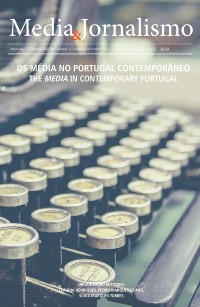Please use this identifier to cite or link to this item:
https://hdl.handle.net/10316.2/47521| Title: | O Telejornal da RTP mostrou o Maio de 68 e escondeu a Crise Académica de 69. Porquê? | Other Titles: | The public television, RTP showed “May 68” in France and hid the “academic crisis of 1969”. Why? | Authors: | Godinho, Jacinto | Keywords: | RTP;academic crisis of 1969;May 68;evanescent mediator;secrecy show;RTP;crise académica de 1969;Maio de 68;espectáculo do sigilo;mediador evanescente | Issue Date: | 2019 | Publisher: | Imprensa da Universidade de Coimbra | Abstract: | Este artigo procura aprofundar a reflexão sobre o impacto político do jornalismo
televisivo durante o período final do Estado Novo. A RTP tem sido pensada como um
dos bastiões do regime de Salazar e Caetano, usada prioritariamente como meio de
divulgação propagandística. A clara predominância de homens próximos destes dois
Presidentes do Conselho no comando da informação televisiva, a governamentalização
dos telejornais com a exclusão de notícias relacionadas com a oposição ou
de qualquer outro assunto que desagradasse ao Governo, leva à conclusão de que
uma RTP manipulada só pode ter funcionado como um instrumento que ajudou a
prolongar a ditadura.
Analisando dois casos semelhantes de agitação estudantil, “Maio de 68” em França
e a “Crise Académica” em Coimbra, ocorridos no curto espaço de um ano entre
1968 e 1969, anos decisivos em que a direcção do Governo mudou de Salazar para
Caetano, verificamos que a estratégia da RTP foi completamente oposta. Analisando
os Telejornais verificamos que a RTP cobriu com abundância de peças os acontecimentos
em França que levaram à paralisação da Universidade da Sorbonne em
Maio de 68, mas um ano depois, em Abril de 1969, decidiu não cobrir noticiosamente
os protestos que levaram ao encerramento da Universidade, à intervenção da GNR e
à prisão de dezenas de estudantes. A RTP mostrava, lá de fora no estrangeiro, o que
não podia ou não queria mostrar cá de dentro, em Portugal. Que razões podem explicar
esta estranha estratégia informativa? Sugerimos neste artigo uma nova interpretação
da política de imagens do Estado Novo e levantamos a hipótese de a televisão
em Portugal ter sido um mediador evanescente do regime ditatorial. This article seeks to deepen the reflection about the political impact of television journalism during the final period of the Portuguese dictatorship. The public television, RTP, has been thought of as one of the last bastions of the regime of Salazar and Caetano, used primarily as a mean of propaganda. The predominance of men close to the regime in the command of the television information and the governmentalization of news programs with the exclusion of topics related to the opposition or any other matter that displeased the government lead to the conclusion that RTP can only be seen as an instrument that helped to prolong the dictatorship. But analyzing two similar cases of student protests, “May 68” in France, and the “academic crisis of 1969”, in Coimbra, we found that RTP strategy was completely opposite. Analyzing the television news, we find that RTP covered largely the events in France that led to the closure of the Sorbonne University in May 1968, but a year later, in April 1969, RTP decided not to cover any of the students protests that also led to the closure of the University, the police intervention and the arrest of dozens of students. RTP showed international events and concealed internal ones. What reasons can explain this strange information strategy? We suggest a new interpretation of the New State image policy and we raise the hypothesis that television in Portugal has been an evanescent mediator of the dictatorial regime. |
URI: | https://hdl.handle.net/10316.2/47521 | ISSN: | 1645‑5681 2183-5462 (PDF) |
DOI: | 10.14195/2183-5462_35_14 | Rights: | open access |
| Appears in Collections: | Media & Jornalismo |
Files in This Item:
| File | Description | Size | Format | |
|---|---|---|---|---|
| o_telejornal_da_rtp_mostrou_o_maio_de_68.pdf | 2.31 MB | Adobe PDF |  |
Items in DSpace are protected by copyright, with all rights reserved, unless otherwise indicated.
